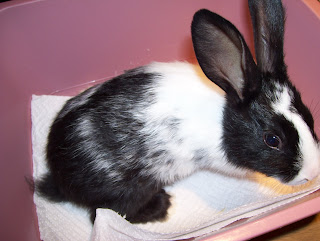The digestion of rabbits has a unique aspect, and that is the formation of cecotropes. Through this special mechanism, these animals can receive more nutrition from what they eat. This special digestive process has been referred to as '
cecotrophy,' '
hindgut fermentation,' '
coprophagy,' or '
pseudorumination.'
What are cecotropes?
Cecotropes, also called 'night feces' or 'soft feces,' are the material resulting from the fermentation of food in a part of the digestive system called the cecum.
Cecotropes are nutrient-rich and are passed out of the body, like feces, but are
reingested by the animal so the nutrients can be absorbed.
Cecotropes have twice the protein, and half of the fiber of the typical hard fecal pellet. They also contain high levels of vitamin K and the B vitamins.
How are cecotropes produced?
To help understand
cecotropes, it is helpful to know something about how the digestive tract of animals make them. As with humans, animals with
hindgut fermentation have an
esophagusthat leads to the stomach. From there, food enters the small intestine, where absorption of the nutrients takes place. The food then passes to the colon. Little, if any, absorption of nutrients occurs in the colon. In animals that have
coprophagy, the large fiber particles pass quickly through the colon and are excreted as typical feces. Through special muscle contractions (reverse peristalsis) in the colon, the nutrient-rich portion of the food is moved back into the cecum, a sac-like structure between the small intestine and colon. This food remains in the cecum, where it is broken down by special bacteria into
absorbable nutrients, such as simple sugars, starches, and amino acids. At a certain time of the day, depending upon the species of the animal, the material from the cecum is moved into and through the colon and passed out through the anus. The animal then ingests this material and it moves through the digestive tract a second time, and the nutrients formed in the cecum are absorbed in the small intestine. Without this process, many of the nutrients in the food would be lost and passed through the colon, and out as typical feces.
If rabbits are not allowed to eat the cecotropes, they will suffer from malnutrition.
In a way,
cecotrophy is similar to the process of ruminant animals chewing their cud. Cows, goats, and other ruminants chew their food once, swallow it, and then the digestive process continues in the
rumen where the fiber starts to be broken down by bacteria. When these animals chew their cud, the material from the
rumen is brought up through the esophagus to the mouth, where it is
rechewed and swallowed. By repeating this portion of the digestive process, ruminants, too, receive more nutrition from their food.
What do cecotropes look like?
Cecotropes are smaller, softer, and more moist than the hard fecal pellets. They are covered with greenish mucus, which makes them stick together. They resemble a small bunch of grapes squished together and are shinier, smaller and darker than a normal fecal pellet.
How often are cecotropes passed?
Cecotropes and the typical hard feces are passed at different times into the colon. Depending upon the species, some animals pass the
cecotropes at night, others at dawn, and others throughout the day. This allows animals to ingest the
cecotropes during periods when they are not normally feeding.
References and Further Reading
Brooks, D. Nutrition and gastrointestinal physiology. In Jenkins, JR. (ed.) The Veterinary Clinics of North America: Exotic Animal Practice. W.B. Saunders Co. Philadelphia, PA; January 1999.
Harkness, JE; Wagner, JE. The Biology and Medicine of Rabbits and Rodents. Williams & Wilkins. Media, PA; 1995.
Jenkins, JR. Gastrointestinal diseases. In Hillyer, EV; Quesenberry, KE (eds.): Ferrets, Rabbits and Rodents. W.B. Saunders Co. Philadelphia, PA; 1997.
Tynes, VV. Managing common gastrointestinal disorders in pet rabbits. Veterinary Medicine, March 2001;226-233


 This kit is a sport. See the spots on the flank? They are a genetic throwback to one of the breeds used in the development of the HT. Most probably the Checkered Giant in the case of the
This kit is a sport. See the spots on the flank? They are a genetic throwback to one of the breeds used in the development of the HT. Most probably the Checkered Giant in the case of the 








